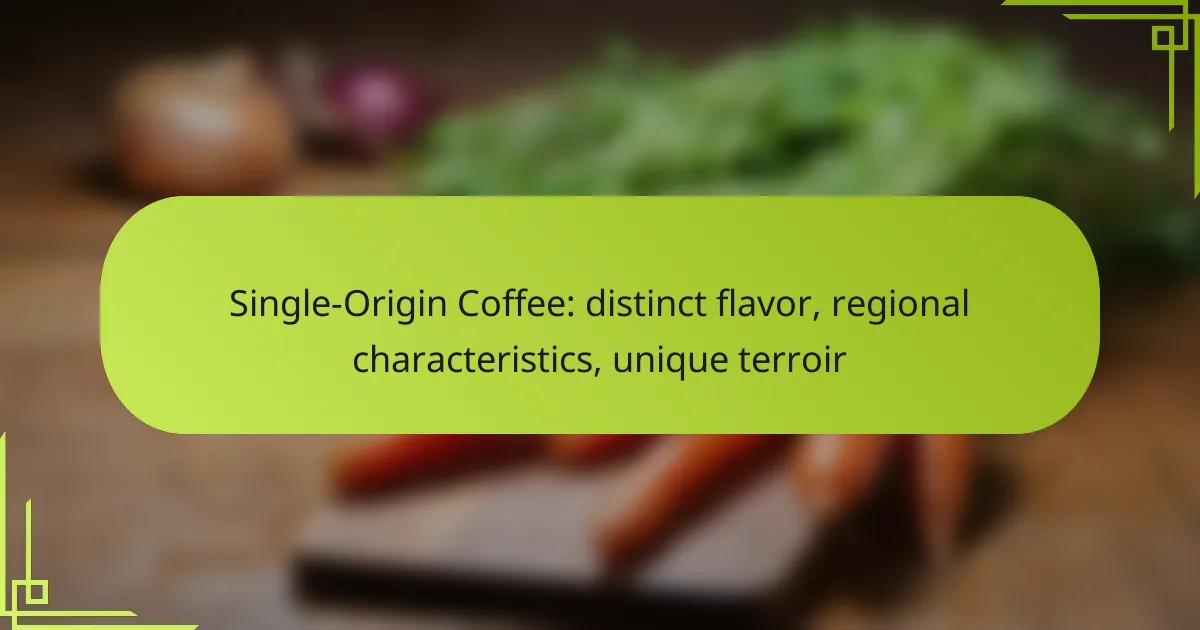Single-origin coffee showcases the unique flavors and characteristics that emerge from specific growing regions. Influenced by factors such as climate, soil composition, and cultivation methods, each coffee variety offers a distinct tasting experience that reflects its terroir. This diversity allows coffee enthusiasts to explore a wide range of aromas and flavor profiles, highlighting the rich tapestry of global coffee cultivation.

What are the distinct flavors of single-origin coffee?
Single-origin coffee offers unique flavors that reflect the specific region where the beans are grown. These flavors are influenced by factors such as climate, soil, and cultivation methods, resulting in a diverse tasting experience.
Flavor profiles by region
Different coffee-growing regions produce distinct flavor profiles. For example, Ethiopian coffees are often fruity and floral, while Colombian varieties tend to be well-balanced with nutty undertones. Brazilian coffees may present chocolatey and sweet notes, showcasing the diversity of single-origin offerings.
When exploring single-origin coffees, consider trying beans from various regions to appreciate the range of flavors. Each region’s unique terroir contributes to the overall taste, making the experience of single-origin coffee particularly rich and varied.
Impact of altitude on taste
Altitude plays a significant role in the flavor of single-origin coffee. Higher elevations typically produce beans with more acidity and complex flavors, as the cooler temperatures slow the maturation process. For instance, coffees grown above 1,200 meters often exhibit brighter and more vibrant profiles.
Conversely, beans grown at lower altitudes may have a heavier body and less acidity. When selecting single-origin coffee, consider the altitude of the growing region, as it can greatly influence the taste and overall quality of the brew.
Processing methods and flavor
The processing method used to prepare coffee beans can significantly affect their flavor. Common methods include washed, natural, and honey processing. Washed coffees tend to have a cleaner taste, while natural processed beans often exhibit fruity and fermented notes.
When choosing single-origin coffee, pay attention to the processing method, as it can enhance or diminish specific flavor characteristics. Experimenting with different methods can lead to discovering your preferred flavor profile within the single-origin spectrum.

How does regional origin affect coffee characteristics?
The regional origin of coffee significantly influences its flavor profile, aroma, and overall quality. Factors such as geography, climate, and soil composition contribute to the distinct characteristics of coffee beans from different areas.
Geographic influences on flavor
The geography of a coffee-growing region plays a crucial role in shaping its flavor. For instance, coffees from mountainous areas often exhibit bright acidity and complex flavors due to the elevation and cooler temperatures. In contrast, beans grown in flat, lowland regions may have a heavier body and less acidity.
Additionally, proximity to water sources can affect the microclimate, leading to variations in humidity and temperature that further influence the beans’ taste. For example, coffees from Colombia are known for their balanced flavor, which is partly attributed to the diverse geography of the country.
Climate and soil impact
Climate conditions, including temperature and rainfall, are vital for coffee cultivation. Ideal coffee-growing climates typically feature moderate temperatures and consistent rainfall throughout the year. For instance, Ethiopian coffees thrive in high-altitude regions with ample rainfall, resulting in fruity and floral notes.
Soil composition is equally important; volcanic soils, rich in nutrients, often produce beans with enhanced flavor complexity. Regions like Costa Rica benefit from volcanic soil, leading to vibrant and rich coffee profiles.
Varietal differences by region
Different coffee varietals are cultivated in various regions, each offering unique flavor characteristics. For example, Arabica beans, prevalent in high-altitude areas, tend to have a sweeter and more nuanced flavor compared to Robusta beans, which are often grown in lower elevations and have a stronger, more bitter taste.
Moreover, specific regions may favor certain varietals due to local growing conditions. For instance, the Bourbon varietal is highly regarded in Central America for its smooth, chocolatey flavor, while the Geisha varietal from Panama is celebrated for its floral and tea-like qualities.

What is unique about the terroir of single-origin coffee?
The terroir of single-origin coffee refers to the specific environmental conditions and characteristics of the region where the coffee is grown, which significantly influence its flavor profile. Factors such as soil composition, altitude, climate, and local farming practices create distinct taste experiences that vary from one region to another.
Definition of terroir in coffee
Terroir in coffee encompasses the unique combination of environmental factors that affect the growth and flavor of coffee beans. This includes the geographical location, climate conditions, and agricultural practices specific to a region. Each of these elements contributes to the overall sensory experience of the coffee, making it distinct from beans grown elsewhere.
Examples of terroir in major coffee regions
Different coffee-growing regions around the world showcase unique terroirs that influence flavor. For instance, Ethiopian coffee often has floral and fruity notes due to its high altitude and diverse soil types. In contrast, Colombian coffee is known for its balanced acidity and sweetness, attributed to its mountainous terrain and consistent rainfall.
Other notable examples include Brazilian coffee, which tends to have a nutty and chocolatey flavor profile due to its warmer climate and lower elevation, and Costa Rican coffee, recognized for its bright acidity and citrus notes, resulting from volcanic soil and high altitudes.
How terroir affects flavor complexity
The complexity of flavor in single-origin coffee is largely determined by its terroir. Variations in soil nutrients can enhance specific flavor notes, while altitude can affect the bean’s ripening process, leading to different acidity levels. For example, beans grown at higher elevations often develop more nuanced flavors compared to those from lower altitudes.
Additionally, local processing methods can further influence flavor. For instance, washed coffees typically have a cleaner taste, while natural processed coffees may exhibit more fruity characteristics. Understanding these aspects of terroir helps coffee enthusiasts appreciate the diverse flavors found in single-origin coffees.

How to choose single-origin coffee?
Choosing single-origin coffee involves understanding the specific characteristics of beans from a particular region, which can greatly influence flavor and aroma. Focus on factors such as the origin, processing method, and roast level to find a coffee that suits your taste preferences.
Criteria for selecting quality beans
When selecting quality single-origin coffee beans, consider the altitude at which they are grown, as higher elevations often yield more complex flavors. Look for beans that are freshly roasted, ideally within a few weeks of purchase, to ensure optimal taste.
Additionally, check for certifications such as Fair Trade or organic, which can indicate ethical sourcing and quality standards. Reading reviews and seeking recommendations can also help identify reputable sources.
Understanding roast levels
Roast levels significantly affect the flavor profile of single-origin coffee. Light roasts tend to highlight the unique characteristics of the beans, preserving their original flavors, while dark roasts can mask these traits with a bolder, more robust taste.
For those new to single-origin coffee, a medium roast often provides a balanced experience, showcasing both the origin’s nuances and the roasting process. Experimenting with different roast levels can help you discover your preferred flavor profile.
Recommended brands and sources
Some well-regarded brands for single-origin coffee include Stumptown, Intelligentsia, and Blue Bottle, known for their commitment to quality and ethical sourcing. Local roasters often offer unique selections that reflect regional characteristics, so exploring nearby options can be rewarding.
Online platforms like Trade Coffee and Atlas Coffee Club allow you to sample various single-origin coffees from around the world, making it easier to find your favorites. Always check for freshness and sourcing information when purchasing to ensure quality.

What are the best brewing methods for single-origin coffee?
The best brewing methods for single-origin coffee enhance its distinct flavors and regional characteristics. Techniques like pour-over, French press, and espresso extraction each bring out unique aspects of the coffee’s terroir.
Pour-over techniques
Pour-over brewing allows for precise control over water flow and temperature, which is essential for highlighting the unique flavors of single-origin coffee. Use a medium grind and water heated to around 90-96°C (195-205°F) for optimal extraction.
Start by wetting the coffee grounds with a small amount of water to bloom for about 30 seconds. Then, pour water in a slow, circular motion over the grounds, ensuring even saturation. Aim for a total brew time of around 3-4 minutes.
French press advantages
The French press method is known for producing a rich, full-bodied cup, making it a great choice for single-origin coffees with bold flavors. Use coarsely ground coffee and steep for about 4 minutes before pressing down the plunger.
This method allows the coffee oils and fine particles to remain in the brew, enhancing the overall mouthfeel. However, be cautious of over-extraction, which can lead to bitterness; adjust steeping time based on the coffee’s characteristics.
Espresso extraction tips
Espresso brewing is ideal for showcasing the concentrated flavors of single-origin coffee, but it requires precision. Use a fine grind and aim for a brew time of 25-30 seconds to extract the best flavors.
Ensure your espresso machine is properly calibrated, and use fresh coffee for optimal results. Experiment with different pressure settings and temperatures to find the perfect balance that highlights the coffee’s unique notes.

How does single-origin coffee compare to blends?
Single-origin coffee comes from a specific region or farm, offering distinct flavors and characteristics unique to that locale, while blends combine beans from various sources to create a balanced flavor profile. The choice between single-origin and blends often depends on personal taste preferences and the desired coffee experience.
Flavor differences
Single-origin coffee typically showcases the unique flavors and aromas of its specific region, influenced by factors like soil, climate, and processing methods. For example, Ethiopian coffees may have fruity and floral notes, while Colombian varieties often present a smooth, nutty profile.
In contrast, blends aim to create a harmonious taste by mixing beans from different origins. This can result in a more consistent flavor, which some drinkers prefer, especially in commercial coffee products. Blends can mask the distinct characteristics of individual beans, leading to a more uniform taste.
When choosing between single-origin and blends, consider your flavor preferences. If you enjoy exploring unique tastes, single-origin coffees are a great choice. However, if you prefer a balanced and familiar flavor, blends might be more suitable.










